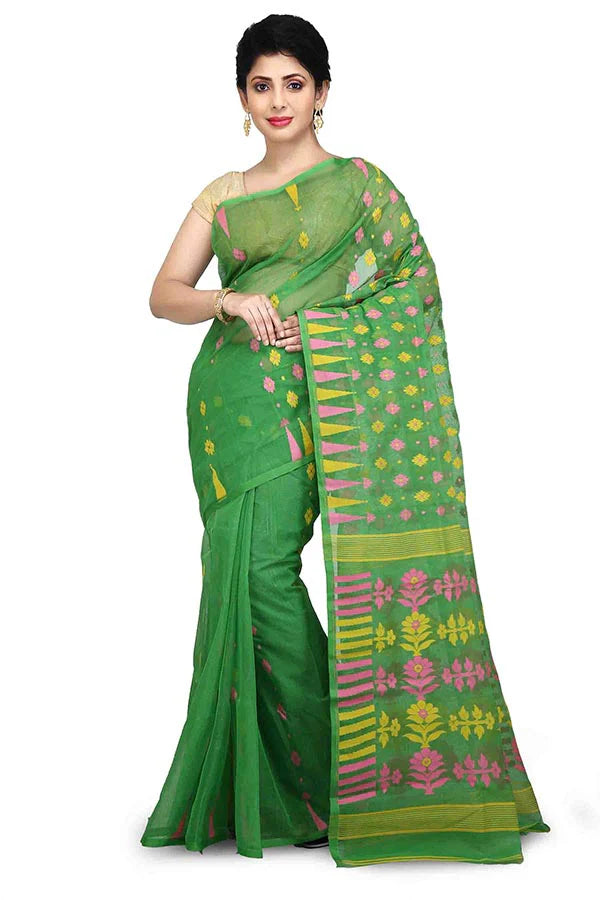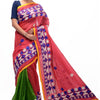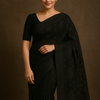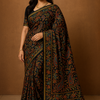Tips for Buying a Dhakai Jamdani Saree
- Posted by Banglarsare Handloom Udyog

Here are some simple tips for buying a Dhakai Jamdani Saree:
- Look for Authenticity: Genuine Jamdani sarees are handwoven, often with a GI tag. Small imperfections in the weave can mean it’s handmade, not machine-made.
- Check Fabric Quality: Original Jamdanis are lightweight and made of soft cotton or silk. The fabric should feel delicate and breathable.
- Focus on the Design: Dhakai Jamdani sarees have intricate floral or geometric designs woven directly into the fabric. The patterns should be clear and even.
- Weaving Style Matters: Authentic sarees have designs woven into the fabric, not printed or embroidered. This is a unique feature of real Jamdani sarees.
- Choose the Right Weight: Dhakai Jamdanis are usually light and comfortable. Heavy sarees may not be genuine or as easy to wear.
- Pick Your Colors: Traditional colors are white with red or black motifs, but modern versions come in many colors. Choose what fits your style or occasion.
- Buy from Reliable Sellers: Trusted shops or artisans are your best bet for authentic sarees. Many reputable sellers provide certificates of authenticity.
- Match the Occasion: For special events, look for detailed, intricate Jamdanis. Simple designs work well for casual wear.
- Check the Price: Authentic Jamdani sarees are handmade and may be pricier. Be cautious of very cheap ones, as they may not be genuine.
- Know How to Care for It: Jamdanis are delicate; dry cleaning or gentle hand-washing keeps them in good shape.
These tips will help you find a beautiful, authentic Dhakai Jamdani saree that you’ll love!
Let us check some interesting, easy-to-read facts about the Dhakai Jamdani Saree:
- Ancient Art with Persian Roots: Jamdani weaving comes from Persian influences, introduced during the Mughal era. The name "Jamdani" means “flower vase” in Persian, inspired by the floral designs on these sarees.
- Handwoven Masterpieces: Each Dhakai Jamdani saree is handwoven on a traditional loom. It can take weeks, or even months, to complete because of the detailed patterns woven into the fabric.
- Named After Dhaka, Bangladesh: These sarees get their name from Dhaka, where the craft started. They have Geographical Indication (GI) status, protecting the unique heritage of Dhakai Jamdani.
- Luxury in the Mughal Era: In Mughal times, Dhakai Jamdani sarees were luxurious items, worn by royalty and nobility. The Mughals helped the craft flourish by supporting its artisans.
- Beautiful, Unique Patterns: Known for their intricate floral and geometric designs, Jamdani sarees are woven into the fabric, not embroidered, making them look seamless and elegant.
- Lightweight and Comfortable: Made from fine cotton, these sarees are airy and lightweight, perfect for the hot climate of the Bengal region.
- Takes Time and Skill: Weaving Jamdani sarees is slow and labor-intensive. It can take two artisans working together for months to complete one saree.
- Recognized by UNESCO: The art of Dhakai Jamdani weaving is a UNESCO Intangible Cultural Heritage of Humanity, honoring its cultural importance and skilled craftsmanship.
- Modern Fashion Appeal: Traditionally, they were white with red or maroon motifs, but today, designers use various colors and styles, making Jamdani sarees popular worldwide.
- Eco-Friendly Choice: Jamdani sarees are made with natural cotton and often organic dyes, making them a great option for those who love sustainable fashion.
These facts show the beauty, tradition, and lasting appeal of Dhakai Jamdani sarees!
-
Posted in
dhakai jamdani saree
Categories
Recent Posts
Popular Products
Please select collection from store admin > customize > Collection page > sidebar
Tags
- Affordable and stylish cotton sarees online
- Affordable Bengali Sarees
- Affordable Hand Painted Saree Online
- affordable Jamdani sarees
- Affordable kantha saree
- airport fashion
- Art Sarees Online
- Artisan embroidered sarees
- Artistic Saree Online
- authentic hand-painted sarees
- Authentic Handloom Saree
- authentic handloom sarees
- Authentic Handloom Sarees Online
- Authentic handwoven sarees
- Authentic Jamdani saree
- Authentic Kantha saree
- Authentic Kantha Sarees
- authentic kantha stitch saree
- Authentic Muslin saree Kolkata
- Baluchari Saree
- Baluchari Silk Saree
- baluchari silk sarees
- Banarasi
- Banarasi vs Jamdani saree
- Bangalore pure silk saree
- Bangalore sarees
- Bangalore silk kantha saree online
- Banglarsare handloom collection
- Banglarsare handloom sarees
- BANGLARSARE HANDLOOM UDYOG
- BANGLARSARE HANDLOOM UDYOG Sarees
- Banglarsare kantha silk saree online
- Banglarsare.com cotton sarees
- Banglarsare.com sarees
- Banlarsare affordable handloom sarees
- beachwear saree
- Bengal Handloom Saree
- Bengal Kantha embroidery
- Bengal Kantha embroidery saree
- Bengal Kantha sarees
- Bengali Atpoure style
- Bengali draping style
- Bengali embroidery design
- Bengali Hand Painted Saree Online
- Bengali Kantha sarees
- Bengali kantha stitch saree
- Bengali saree care guide
- Bengali Saree Collection
- Bengali saree for wedding
- Bengali Saree Shop Online
- Bengali saree types
- Bengali sarees
- Bengali Sarees for Women
- Bengali silk sarees
- Bengali Tant Saree
- Bengali Tant sarees
- Best Cotton Saree
- Best cotton sarees
- best cotton sarees for summer
- Best fabric sarees for Holi festival
- Best gift ideas with Kantha embroidery sarees
- Best hand painted sarees for festivals
- Best handloom cotton sarees for everyday use
- Best handloom sarees for Mahashivratri
- Best Jamdani sarees for weddings and festivals
- Best kantha stitch sarees for partywear
- Best online saree store Kolkata
- Best Saree Accessories for Eid
- Best saree colors for Holi festival
- Best saree colors for skin tone
- best saree for haldi ceremony
- best sarees for daily wear in Kolkata
- Best sarees for gifting
- Best sarees for Holi
- Best sarees for weddings
- Best way to clean tant saree
- Best ways to reuse old handloom sarees
- blended silk kantha saree
- Blouse Designs
- Bomkai Silk Saree
- Braided hairstyles for sarees
- Breathable sarees for summer
- Bridal hairstyles for silk sarees
- bridal saree for haldi
- bright yellow saree for bride
- budget Jamdani sarees
- Budget Tant Sarees
- Buy authentic Kantha silk sarees online
- buy Bengali cotton sarees online
- Buy Bengali sarees online
- Buy Cotton Saree Online
- Buy Eid Sarees Online
- Buy Hand Painted Sarees
- buy handloom sarees online
- buy Jamdani saree online
- Buy Jamdani sarees online
- Buy Kantha saree online
- Buy Kantha stitch saree online
- Buy Muslin Silk Saree at Best Price
- Buy Muslin Silk Sarees Online
- Buy Online Hand Painted Saree
- Buy sarees online for Mahashivratri
- Buy sarees online Kolkata
- Buy Tant Saree Online
- Caring for handwoven Jamdani sarees
- Casual cotton sarees
- Casual hairstyles for sarees
- Celebrity saree hair looks
- Celebrity-inspired hairstyles
- Chic hairstyles for festive sarees
- chic travel outfits
- chiffon yellow saree
- Classic bun for sarees
- Colorful sarees for Holi
- Comfortable Cotton Saree
- Comfortable sarees for women
- Contemporary Eid Saree Looks
- Contemporary hairdos for traditional sarees
- Cotton Hand Painted Saree
- cotton Jamdani saree
- Cotton saree for daily wear
- Cotton Saree for Summer
- Cotton Saree Online
- Cotton Saree Online Shopping
- Cotton sarees for Holi
- cotton sarees online Kolkata
- Creative ideas for upcycling old sarees
- cultural fashion
- Cultural heritage sarees
- cultural importance of yellow saree
- Custom Hand Painted Saree
- Daily Wear Cotton Saree
- Designer Cotton Saree
- Designer Hand Painted Sarees
- Designer Jamdani saree
- Designer Kantha silk sarees
- Designer kantha stitch saree under ₹4000
- Designer Sarees for Eid
- dhakai jamdani saree
- Dhakai Jamdani saree under 4000
- Dhakai Jamdani Sarees
- Dhakai Jamdani sarees online
- difference between handloom and powerloom sarees
- DIY home décor with Kantha work fabrics
- DIY Kantha fabric ideas
- Duel Thread Work Kantha Stitch Saree
- Easy-to-maintain sarees
- Eco-friendly fashion
- Eid Saree Styles
- Eid Sarees in Bangladesh
- Elegant Eid Sarees
- Elegant Farewell Outfit
- Elegant hairstyles for sarees
- elegant saree for haldi
- elegant travel wear
- Elegant updos for sarees
- Embroidered Sarees for Eid
- Ethnic wear for Holi
- Famous sarees of Kolkata
- Farewell Party Saree
- Fashion trends
- Fashionable Saree Look
- Festival sarees
- Festive Saree Collection
- Festive Sarees Online
- Festive Silk Sarees
- Fishtail braid saree hairstyle
- Floral Print Sarees
- Genuine Kantha stitch saree
- Georgette sarees for Holi
- georgette yellow saree
- Gorgeous Kantha Stitch Sarees
- guide to buying cotton sarees online
- Gujarati stitch kantha saree at best price
- Gujarati Stitch sarees
- Gujrati Stitch Saree
- Hair accessories for sarees
- Hairstyles for Bangalore printed silk sarees
- Hairstyles for formal events with sarees
- Hairstyles for Indian sarees
- Hairstyles to complement saree embroidery
- haldi ceremony attire
- haldi ceremony outfit ideas
- haldi ceremony saree
- haldi dress for bride
- haldi saree look
- haldi special sarees
- half-down hairstyle saree
- Half-up
- Hand embroidered kantha saree
- Hand embroidered Kantha sarees
- Hand Painted Saree Kolkata
- Hand Painted Saree Online Kolkata
- Hand Painted sarees
- Hand Painted Sarees Online
- Hand painted sarees with blouse piece
- hand stitch saree
- Hand thread work kantha saree online
- hand thread work saree
- Hand Work Pure Kantha Stitch Saree
- hand-embroidered
- Hand-Embroidered Kantha Sarees
- hand-painted sarees
- Hand-painted sarees online
- Handcrafted Kantha saree
- Handcrafted Kantha Stitch Sarees
- Handcrafted Saree Designs
- Handcrafted sarees
- Handcrafted Sarees Online
- Handloom Cotton Saree
- Handloom Cotton sarees
- Handloom cotton sarees 2025
- handloom cotton sarees online
- Handloom Hand Painted Sarees
- Handloom Muslin saree online
- Handloom Organic Sarees
- Handloom saree maintenance
- Handloom Sarees for Eid
- Handloom sarees for Mahashivratri
- Handloom Sarees for Nobo Barsho
- Handloom sarees from Bengal
- handloom sarees Kolkata
- Handloom sarees online
- Handloom Tant Sarees
- Handmade fabric crafts
- Handmade Kantha saree
- Handmade Kantha sarees
- Handmade sarees online
- Handwoven Cotton Saree
- Handwoven Jamdani saree
- handwoven sarees India
- Heritage handloom sarees
- History of Hand-Painted Sarees
- Holi fashion tips
- Holi outfit ideas
- Holi sarees
- Holi special sarees
- How to choose a cotton saree for daily wear
- how to choose cotton saree
- How to choose the best saree for Holi
- How to identify an original Jamdani saree
- how to identify authentic handloom sarees
- How to keep saree fresh
- How to maintain a tant saree
- How to repurpose old Kantha stitch sarees
- How to style a saree for Holi
- Indian handloom sarees
- Indian Sarees for Eid
- Indian sarees for Holi
- Ironing tips for tant saree
- Jamdani saree
- Jamdani saree collection
- jamdani sarees
- Jamini Roy Saree
- Jewel Tone Sarees
- Kanjeevaram
- Kantha embroidery
- Kantha embroidery sarees
- Kantha embroidery silk sarees
- kantha saree identification
- kantha saree online
- Kantha saree online shopping
- Kantha saree shopping tips
- Kantha saree under 4000
- Kantha sarees and their cultural significance
- Kantha sarees for gifting
- Kantha sarees for special occasions
- Kantha sarees heritage
- Kantha sarees online
- Kantha sarees vs machine-made
- Kantha Sarees with Blouse Piece
- Kantha silk for weddings
- Kantha silk sarees
- Kantha silk sarees for weddings and festivals
- kantha stich saree
- Kantha stitch creativity
- Kantha stitch embroidery
- Kantha stitch saree
- Kantha Stitch Saree design
- Kantha Stitch Saree on Tussar Silk
- Kantha stitch saree online
- Kantha stitch saree price
- Kantha stitch saree reuse
- kantha stitch sarees
- Kantha Stitch sarees Kolkata
- Kantha stitch silk saree
- Kantha work fabrics
- Kantha work home décor
- kantha work saree
- Kantha work saree Kolkata
- Kantha work sarees
- Kantha work sarees Kolkata online
- Kolkata handloom saree shops online
- Kolkata sarees online
- Latest saree trends 2025
- Latest sarees for women in Kolkata
- Lightweight Cotton Saree
- Lightweight cotton sarees
- Lightweight sarees for all-day comfort
- Lightweight sarees for festive occasions
- Lightweight sarees for Holi celebrations
- Lightweight sarees for summer
- Linen Saree for Summer
- Luxurious Silk Fabric
- Luxury ethnic wear
- Luxury Sarees for Eid
- machine made kantha saree
- Madhubani Print Saree
- Mahashivratri 2025 sarees
- Mahashivratri special saree collection
- Maheshwari Silk Cotton sarees
- Messy bun saree look
- Midnight Blue Kantha Stitch Saree
- Modern hairstyles for sarees
- Modern Jamdani sarees
- Modern Saree Draping Styles
- Modern Saree Trends
- Modern twists on traditional saree hairstyles
- Monochrome Eid Sarees
- Multi-Colour Kantha Stitch Saree
- Murshidabad silk saree
- Murshidabad Silk Sarees
- Muslin Jamdani saree
- Muslin Jamdani sarees online India
- Muslin saree
- Muslin Silk Saree
- Muslin silk saree for wedding
- mustard yellow saree for haldi
- Office wear sarees
- Old saree makeover
- Online Eid Saree Shopping
- Online Muslin saree
- Online Muslin silk saree in Kolkata
- Online saree boutique Kolkata
- Online Saree Shopping for Poila Baishakh
- Online Saree Shopping Kolkata
- Online traditional sarees for women
- Organic handloom sarees Kolkata
- Organza Eid Sarees
- Pallu Designs
- partywear Jamdani saree
- Partywear Kantha Sarees
- Pastel Sarees for Eid
- Perfect hairdos for Indian weddings
- Poila Baishakh Saree
- Preserve tant saree fabric
- Prevent saree color fading
- Printed Sarees for Eid
- pure cotton handloom sarees
- Pure Cotton Saree
- Pure Handloom Organic sarees
- Pure Silk Hand Painted Saree
- Pure silk kantha saree
- Red silk hand painted saree online
- Removing stains from saree
- Repurpose vintage sarees
- Repurposed silk sarees
- Reuse Kantha embroidery
- Saree Blouse Designs
- Saree color
- Saree color guide
- Saree color trends
- Saree draping styles
- Saree for a Farewell Party
- Saree for a Party
- Saree for College Farewell
- saree for haldi ceremony for bride
- saree for pre-wedding rituals
- Saree maintenance hacks
- Saree storage solutions
- Saree Store in Kolkata
- Saree Styling Tips for Eid
- Saree trends 2025
- Sarees for Bengali New Year
- Sarees for Holi
- Seal Brown Kantha Stitch Saree
- Shantiniketan Kantha Stitch Saree
- Shantiniketan silk kantha saree online
- Shop Muslin silk sarees with zari
- sightseeing outfits
- Silk Kantha sarees
- Silk Muslin sarees
- Silk Saree for Farewell
- Silk sarees with embroidery
- silk yellow saree for haldi
- Sleek ponytail for saree
- Soft breathable cotton sarees
- Soft Cotton Saree for Women
- Soft cotton sarees
- soft Jamdani saree
- Soft waves hairstyle
- Stylish saree hairdos
- stylish saree looks
- Summer Special Cotton Saree
- Sustainable fashion ideas
- Sustainable fashion sarees
- Sustainable fashion with recycled silk sarees
- Sustainable sarees online
- Swarnachari saree
- Taant Cotton Saree
- Tangail Jamdani saree
- Tant saree care
- Tant Saree Collection
- Tant Saree for Festival
- Tant saree online
- Tant saree preservation tips
- Tant Saree under 2500
- Tant Silk Saree Online
- Timeless Farewell Fashion
- Timeless Saree Fashion
- Tips for styling a Jamdani saree
- Top Hand Painted Sarees
- Traditional Bengal sarees
- Traditional Bengali Saree
- Traditional Bengali sarees
- Traditional Cotton Saree
- Traditional Eid Sarees
- Traditional embroidery upcycling
- Traditional hairstyles for sarees
- Traditional Hand Painted Saree
- Traditional handwoven Kantha silk sarees
- Traditional Indian hairstyles
- Traditional Indian sarees
- traditional Jamdani saree
- Traditional kantha saree designs
- Traditional Kantha sarees
- Traditional Kantha stitch saree
- Traditional Muslin sarees India
- Traditional saree
- Traditional saree care guide
- Traditional Saree Styles
- Traditional sarees for Holi
- Traditional sarees for Mahashivratri
- Traditional Sarees for Poila Baishakh
- Traditional sarees for puja celebrations
- traditional yellow saree
- Traditional yet modern cotton sarees for women
- Transforming Kantha embroidery into accessories
- travel fashion
- Trendy Eid Sarees Online
- Tussar silk Kantha saree
- Tussar Silk Saree
- Tussar silk saree Bengal
- Tussar Silk Sarees Online
- Types of sarees in Bengal
- Unique gift ideas using old Kantha embroidery
- Unique gift ideas with Kantha sarees
- Unique hand painted sarees India
- Unique handcrafted sarees
- Unique handwoven sarees for women
- Upcycling old sarees
- Uppada Jamdani saree
- Vibrant Colors
- Washing tips for tant saree
- Wedding hairstyle ideas for sarees
- What to wear for Holi celebrations
- Where to buy authentic Jamdani sarees online
- Where to buy hand painted sarees online
- where to buy handloom cotton sarees in Kolkata
- Where to buy kantha sarees online
- Where to buy Mahashivratri sarees online
- White Stylish Kantha Stitch Saree
- why choose saree for haldi
- yellow saree
- yellow saree for bride
- yellow saree for haldi
- yellow saree for Indian weddings
- yellow saree ideas for haldi
- yellow saree significance
- yellow saree styles
- yellow saree with floral jewelry
- Zari Work Sarees






